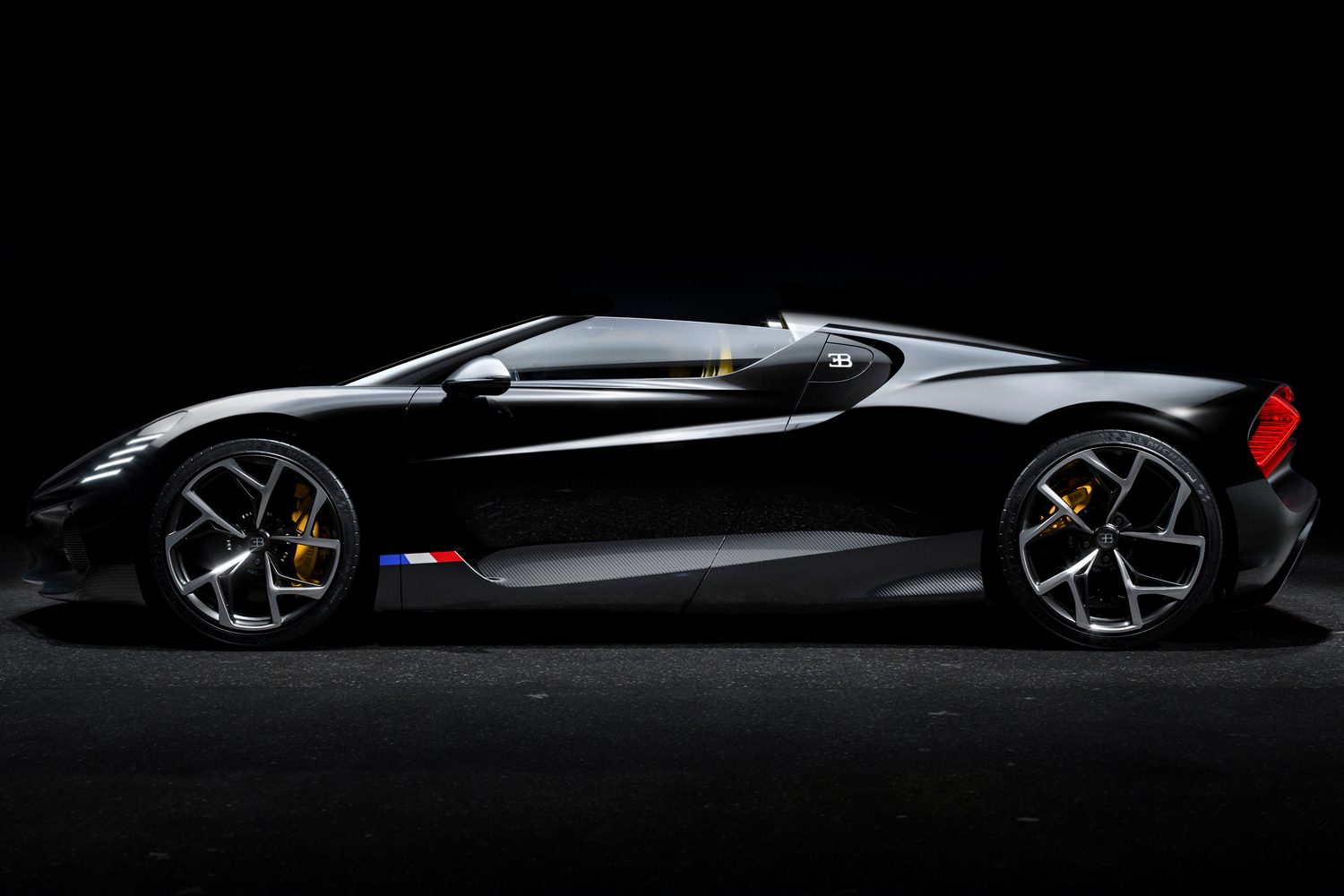Bugatti has revealed the W16 Mistral roadster, a convertible model that it says will mark the final outing for the firm's legendary sixteen-cylinder engine when deliveries begin in 2024.
Making its debut at Monterey Car Week in California, the Mistral will represent the end of an era for the quad-turbo 8.0-litre engine first seen in the Bugatti Veyron in the early 2000s.
Chasing records
Bugatti is aiming for the engine to go out with a bang, however, targeting the title of world's fastest convertible for the Mistral, planning to take the accolade from the Hennessey Venom GT Spyder, which currently holds the record at 428km/h.
To get there, the Mistral has undergone quite a bit of re-engineering compared to the Chiron on which it's based in addition to using an engine in the same 1,600hp state of tune as that seen in the Chiron Super Sport 300+. Although the Super Sport is known to be capable of breaking the magic 300mph (483km/h) barrier, the Mistral won't be nearly that fast, with a top speed of somewhere in the 420-435km/h range.
More than just a roof chop
Starting at the front, the trademark horseshoe grille is wider than that seen on either the Chiron or other Bugatti specials such as the Voiture Noire in order to better supply air to the radiators and intercoolers; the headlamps are unique too, their four-light signature symbolising the Mistral's four turbos and four-wheel drive, while channelling air into the wheel arches in order to reduce drag.
Modifying the Chiron's carbon-fibre monocoque to facilitate a convertible body style has allowed Bugatti's engineers to shape the windscreen into a V-shaped wraparound that is curved, but not so much that it distorts the driver's view of the road ahead.
Whereas the Chiron's distinctive C-shaped side intakes usually supply air to the engine and oil coolers, to account for changes to the body shape, they only feed the oil coolers in the Mistral, with the air inlets for the engine now right behind the occupants' heads, presumably generating a huge amount of noise as they deliver up to 70,000 litres of air every minute.
Those air intakes, made from carbon-fibre, also work as rollover hoops in the event of an accident, but serve an aesthetic function too.
The styling of the Mistral (named after a wind that blows along the French Riviera) was, according to the designers, inspired by that of the 1934 Bugatti Type 57 Grand Raid, a striking black and yellow convertible with bodywork by Swiss coachbuilder Gangloff currently housed in a museum in the Netherlands. The Mistral's most visible throwback to the past comes in the form of those air intakes that look like the fairings often found behind the seats of old sports cars, including the Grand Raid.
The rear lights are also designed with an aerodynamic function in mind. Bugatti's deputy design director, Frank Heyl, explained the arrangement of the rear-end, whose X-shaped lights are seemingly inspired by those seen on the Bugatti Bolide, a track-only hypercar unveiled in 2020.
"The X-taillight," said Heyl, "serves the function of venting the side oil coolers through ducts connecting the triangular negative space in between the X beams to the side radiators.
"Therefore, a pressure drop is created between the side intakes and the outlets at the back of the W16 Mistral which helps to manage the mid-temperature cooling circuit of the mighty W16 most effectively."
A genuine Rembrandt (Bugatti)
The Grand Raid, however, isn't the only vintage Bugatti to which the Mistral makes reference. The interior is an entirely modern affair with buyers having almost endless options when it comes to a choice of leather and colourways, but there's one tiny detail that harks back to the Bugatti Type 41 Royale of the late twenties and early thirties, one of the largest cars ever made - of which seven were built. Though designed as a limousine, the Royale generally featured convertible or semi-convertible bodies, as was the style at the time and all were, incidentally, powered by a 12.0-litre eight-cylinder engine, an ancestor in its sheer scale and ambition of the W16.
The radiator cap of the Royale featured a small sculpture of a dancing elephant and that's a design also found in the interior of the Mistral. The Mistral's gear shift lever, hewn from a single block of aluminium, contains, inset and trapped in amber, a wooden representation of the Royale's dancing elephant. The sculpture was originally created by Rembrandt Bugatti, younger brother of company founder Ettore Bugatti, a brilliant, tortured artist who committed suicide in 1916 aged just 31.
Last orders
"For the final roadgoing appearance of Bugatti's legendary W16 engine, we knew we had to create a roadster," said Bugatti's CEO, Mate Rimac.
"Well over 40 per cent of all Bugatti vehicles ever created have been open-top in design, establishing a long lineage of performance icons that - to this day - are revered the world over. In the Chiron era there had, to-date, been no roadster, so the introduction of W16 Mistral continues this legacy, driven by enormous demand from our clients for an all-new way to experience the mighty performance of our iconic engine."
With the Mistral having been shown to select Bugatti customers ahead of its unveiling at Monterey, all 99 examples due to be built have already sold out. Prices, Bugatti said, were around the €5 million mark.






















